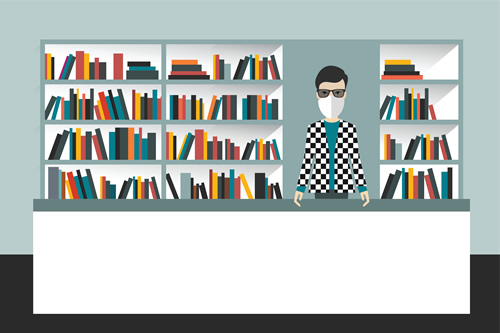New questions from school librarians…
Will ultra violet disinfectant devices damage books?
How long should I quarantine a book before circulating it again?
How can I use technology to coordinate curbside pick-up for students who want to check out print books?
Meet the same old challenges…
How can I ensure teachers know about the content available in my library?
My principal wants to convert my library into a classroom. What should I do?
My budget is on hold until further notice.
Back-to-school season is often chaotic, but the anticipation of a new school year can also be exciting. 2020 brought chaos, anticipation, trepidation, and change. As districts pivot to new ways of teaching and learning, school librarians must also grapple with how to do their jobs in the COVID-19 virtual environment.
Related content: How school librarians can save democracy
The very nature of a library implies physical books stored on rows of shelves. But with school closures the norm—not the exception—students no longer have access to the place many of them found comfort and knowledge: the school library.
Of the 25,000 customers who responded to a recent Follett survey, only 15 percent of schools are delivering fully in-school instruction. What’s more, the American Association of School Librarians recently surveyed more than 1,000 professionals and found that more than 40 percent of school libraries will not reopen this school year.
In many districts across the country, the librarian’s job description had not been updated to reflect a “future ready” world that includes the delivery of digital resources, curriculum partnerships, and community connections. When you layer on a pandemic that includes hybrid and remote learning, there is no job description available. But resourceful school librarians from coast to coast are finding innovative ways to work in a system that has no precedent.
“Librarians save lives by handing the right book at the right time to a kid in need.” (Judy Blume)
Librarians, by nature, want to help young readers—and each other. This has never been more evident than in recent discussions in the Future Ready Librarian Facebook group. Michigan school librarian Lisa Smith Brakel asked, “We are face-to-face this year. My school is using a ‘fogger’ to disinfect classrooms. I am worried about the library books. Should the fogger be used in the library?”
Leave it to a librarian to come up with an inventive makerspace-style solution: hang plastic shower curtains from the dollar store in front of the bookshelves to protect the books.
Other school librarians who have in-person instruction in their schools are wearing out their book carts as they wheel books from classroom to classroom to ensure students have materials they are excited about—even if they can’t visit their library in person. Massachusetts librarian Kerry Roche Ferguson said she decorated “a cart, aka ‘book bus,’ and [am] lugging it down two flights of stairs to the other end of the building to make checkout fun for the kids.”
For those with all-remote learning, taking their library online is a challenge—but is also rewarding.
“I’m creating a lot of digital content, which takes a long time but is pretty fun!” said California librarian Christine Jensen. “I just started doing unboxing videos when book shipments arrive and I read first chapters from four different books every week. I’m running four virtual book clubs and doing book talks in a way I never have before.”
Librarians are even thinking ahead by having students fill out surveys about the books they like to read, so if a student can’t be in school due to COVID, the librarian can easily select books to send home.
“We are trying to get physical library books in rotation, and are figuring out logistics and safety,” said Washington librarian Traci Plaster Chun. But in addition to getting physical books to students, Chun says librarians are also playing a greater role with families. “We have been supporting parents in this pandemic, which has been a shift. Teachers and parents are working so hard; I feel it’s my role to help make their jobs easier with tech, resources, eBooks, and whatever they need. We know our students, our curriculum, our teachers, and so it makes sense that we jump in. We can personalize for our families.”
To combat the COVID-slide, another district is strategizing how to get parents reading more and is planning a book club for Spanish-speaking parents.
For those “virtual librarians,” Future Ready Librarian spokesperson and Van Meter Community School District librarian Shannon McClintock Miller is hosting webinars to spark ideas and share best practices across the country because the reality is no one has done this before. But it’s an opportunity to define that future job description.
“I think the part of my job that has changed the most is the amount of collaboration I am doing with teachers, administrators and families,” Miller said. “I have always done a lot of collaboration, but now we are planning, creating and teaching together more than ever. And they are so open to all ideas I bring to the table—resources, technology, innovative ideas and projects. A wall has been taken down. It’s one of the best things.”
Whether in-person, hybrid or remote, one thing has not changed for school librarians is their desire to connect readers with books. While there’s no book with answers on how to be a librarian during a pandemic, there is resourceful community of peers who are eager to share ideas and solutions. And when school librarians collaborate, one thing is certain: we will figure it out together!
- The making of a literary award winner - November 25, 2024
- Dog Man vs. To Kill a Mockingbird - August 19, 2024
- Boycotting book fairs no more - May 27, 2024


